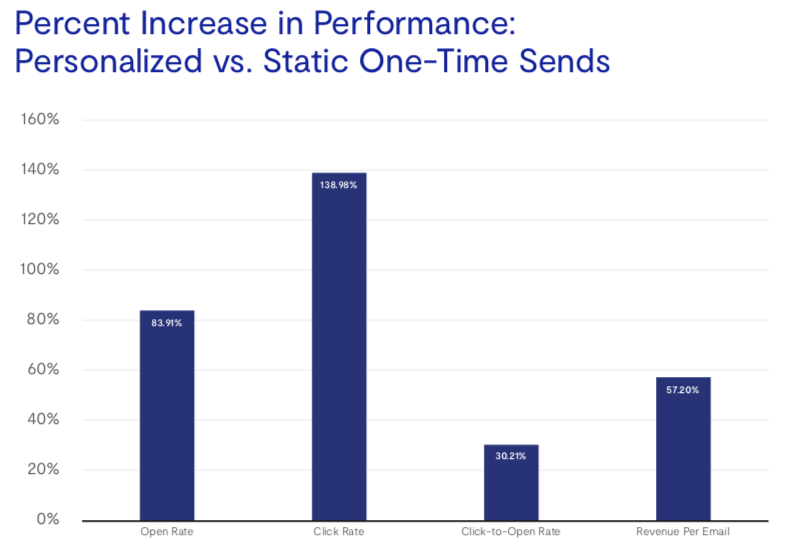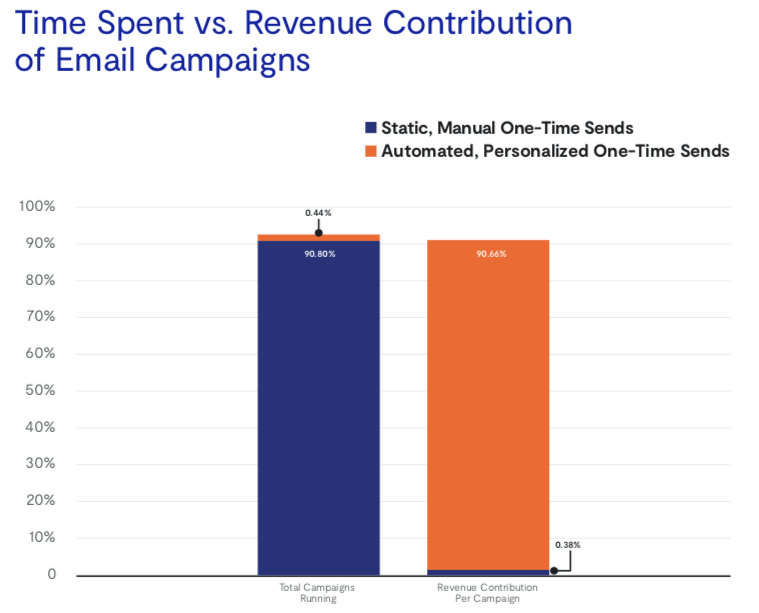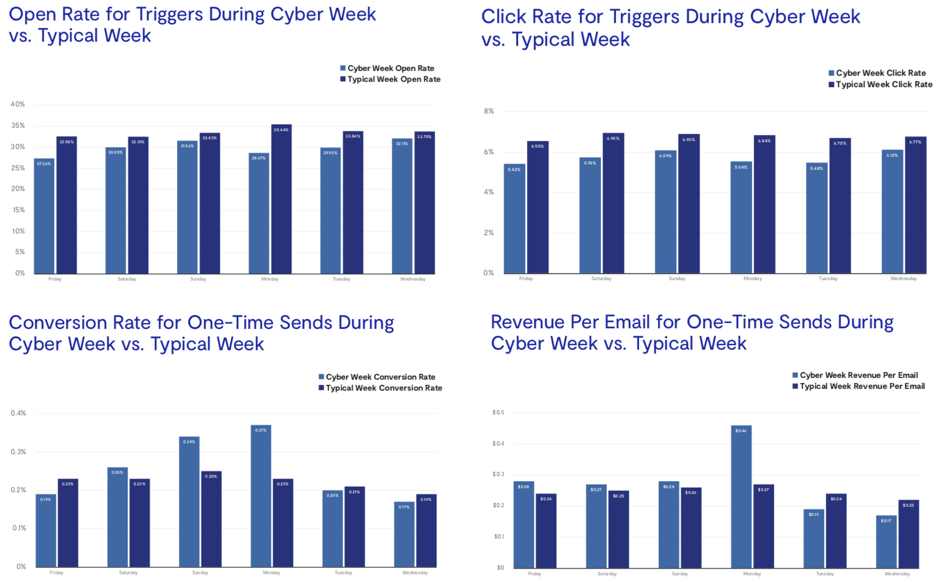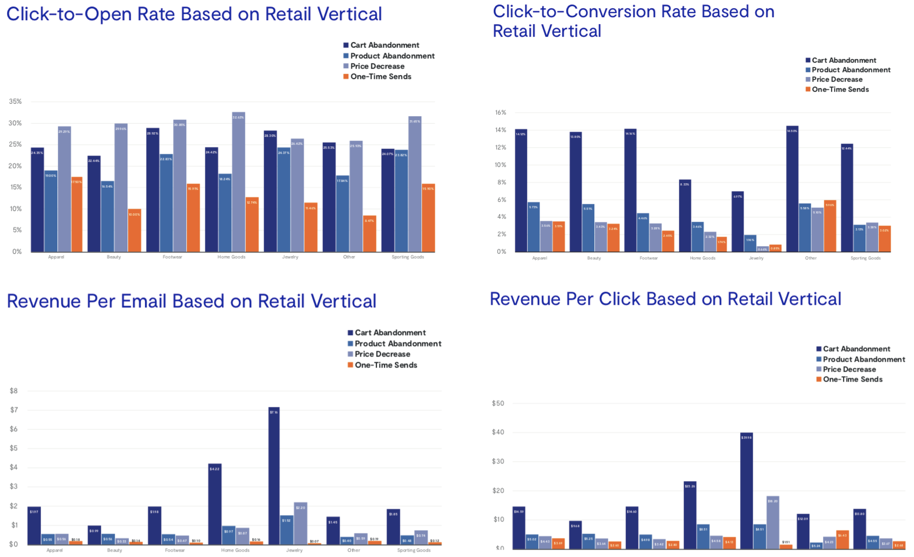
Email Benchmarks: Inside the Performance of One-Time Sends
In the email marketing world, triggered emails often get all the praise. These bottom-of-the-funnel emails are rockstars: They run on their own in the background and boast high conversion rates, meaning they produce significant revenue, especially in relation to time spent.
But when done correctly, one-time sends — emails that are not tied to a specific change in behavior or product and focus on brand awareness, promotions and newsletters — can prove equally as powerful for your email marketing program.
There are several internal and external factors that impact the performance of one-time sends. Let’s take a look at each.
Internal Factors that Impact the Performance of One-Time Sends
One-time sends might seem very straightforward, but there’s a lot more to these emails than meets the eye. Just consider all the options you have when it comes to creating one-time sends:
|
Static Send the exact same email to all recipients |
Personalized Include dynamic product recommendations, content and/or offers that change based on each recipient’s interests |
|
|
Full List Send the email to your entire subscriber list |
OR |
Targeted Audience Send the email to a subset of your subscriber list based on specified interests, lifecycle stage, purchase history, etc. |
|
Single Send Send the email once |
Recurring Send Set up the email once but have it send on a recurring basis (e.g. weekly, monthly) |
Not surprisingly, personalizing one-time sends has an enormous impact on email performance. For example, personalized one-time sends delivered significant gains in opens (+83.91%), clicks (+138.98%), click-to-opens (+30.21%) and revenue per email (+57.2%) compared to static one-time sends for one athletic retailer.

Meanwhile, setting up a recurring, personalized one-time send delivers even bigger gains, as it not only improves email performance, but it also decreases the effort required from your marketing team to send the email — putting it in the league of those rockstar triggered emails.
Consider the case of an IR 100 apparel retailer that recently launched one such campaign with an automated build and delivery of recurring one-time sends, known as a Smart Promo™ campaign. The Smart Promo™ campaign only made up less than 0.5% of the retailer’s live email campaigns, but it contributed to just over 90% of campaign revenue from email.

External Factors that Impact the Performance of One-Time Sends
The information above is essential for understanding everything that’s possible with one-time sends. But to put this information into action, you also need to understand how specific external circumstances — such as seasonality and retail vertical — also impact the performance of one-time sends.
Seasonality
Looking at Cyber Week, arguably the most important time of year for retailers, reveals an interesting pattern of performance for one-time sends.
While open and click rates for one-time sends during this seasonal blockbuster decrease compared to open rates for a typical day, conversion rates and revenue per email increase.

This trend indicates that consumers are not only ready to buy during this time of year, but also ready to make larger purchases than they would year round.
Given that once shoppers click through a one-time send during Cyber Week they are more likely to buy (and buy more), the retailers that focus on efforts to increase opens and clicks will be well-positioned for a record-breaking Black Friday and Cyber Monday. Two of the best ways to make these improvements include adding send-time optimization and featuring personalized content within the email.
Retail Vertical
Comparing the performance of one-time sends to three of the highest-performing triggered emails (cart abandonment, product abandonment and price decrease) based on retail vertical also delivers noteworthy insights.
For instance, while one-time sends lag behind the triggered emails in terms of click-to-open rate, they see similar click-to-conversion rates as price decrease emails. This pattern holds true across the board, with a near even match in benchmarks for the two emails for apparel and beauty retailers.
Additionally, while one-time sends see lower revenue per email than the triggered emails, they perform much better by comparison when looking at revenue per click (with apparel and beauty retailers seeing the closest match in revenue per click between one-time sends and price decrease triggers).

The click-to-conversion rates and revenue per click rates of one-time sends compared to price decrease emails is particularly impressive because price decrease emails, which create a high sense of urgency and typically go to a targeted audience, usually deliver some of the best results. This performance speaks to the value of personalizing one-time sends based on factors like product recommendations, content and offers featured.
Benchmarking Your One-Time Sends
As you build out different types of one-time sends, how do you measure success? Download Bluecore’s 2019 Retail Email Benchmark Report to get the email benchmarks you need to measure the performance of one-time sends (and beyond) and in a variety of circumstances.






